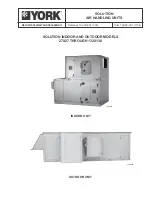
520413-BIM-A-0209
12
Johnson Controls Unitary Products
support purposes, but they must be completely insulated from
each other.
The liquid and suction service ports on the condenser section
permit leak testing, evacuation, and partial charging of the field
piping and the evaporator without disturbing refrigerant stored
in the condenser during initial installation.
Before beginning installation of the main lines, be sure that the
evaporator section has not developed a leak in transit. Check
pressure at the Schrader valve located on the header of each
coil. If pressure still exists in the system, it can be assumed to
be leak free. If pressure DOES NOT exist the section will need
to be repaired before evacuation and charging is performed.
A filter-drier MUST be field-installed in the liquid line of every
system to prevent dirt and moisture from damaging the system.
Properly sized filter-driers are shipped with each condensing
section.
NOTE:
Installing a filter-drier does not eliminate the need for
the proper evacuation of a system before it is charged.
A field-installed moisture indicating sight-glass should be
installed in the liquid line(s) between the filter-drier and the
evaporator coil. The moisture indicating sight-glass can be used
to check for excess moisture in the system or used as a visual
means to verify refrigerant charge.
Both condenser and evaporator sections have copper sealing
disks brazed over the end of liquid and suction connections.
The temperature required to make or break a brazed joint is
high enough to cause oxidation of the copper unless an inert
atmosphere is provided.
NOTE:
Dry Nitrogen should flow through the system at all
times when heat is being applied and until the joint has
cooled. The flow of Nitrogen will prevent oxidation of
the copper lines during installation.
Always drill a small hole in sealing disks before unbrazing to
prevent the pressure in the line from blowing them off.
NOTE:
Solenoid and hot gas bypass valves (if used) should be
opened manually or electrically during brazing or
evacuating.
NOTE:
Schrader valves located on unit service valves should
have their stem removed during brazing to prevent
damage to the valve.
Start Installation
Start Installation of main lines at the condensing section. Verify
the service valves are fully seated by screwing the stem of both
valves down into the valve body until it stops. Remove the
Schraded valve stem and connect a low-pressure nitrogen
source to the service port on the suction line valve body. Drill a
small hole in the sealing disk; the flow of Nitrogen will prevent
any debris from entering the system. Wrap the valve body with
a wet rag to prevent overheating during the brazing process.
Overheating the valve will damage the valve seals. Unbraze the
sealing disk, cool the valve body and prepare the joint for
connections of the main lines. Repeat for the liquid line valve
body.
Connect the main liquid line to the liquid line connection on the
condenser section, while maintaining a flow of Nitrogen. Cool
the valve body and replace the Schraded valve stem on the
service port of the liquid line service valve.
Install the liquid line from the condensing unit to the evaporator
liquid connection, maintaining a flow of nitrogen during all
brazing operations.
The filter-drier and sight glass must be located in this line, close
to the evaporator.
Connect a low-pressure nitrogen source to the Schrader valve
located on the evaporator section coil headers. Drill a small
hole in the sealing disks, the flow of Nitrogen will prevent any
debris from entering the system. Unbraze both liquid and
suction sealing disks and prepare the joints for connections of
the main lines.
Connect the main liquid line to the liquid line connection on the
evaporator section, while maintaining a flow of Nitrogen.
Make the suction line connection at the evaporator and run the
line to the condensing unit. Connect the main suction line to the
suction line connection on the condenser section, while
maintaining a flow of Nitrogen. Cool the valve body and replace
the Schraded valve stem on the service port of the liquid line
service valve.
Once the brazing process is complete, leak testing should be
done on all interconnecting piping and the evaporator before
proper evacuation to 500 microns is performed. Once the line
set and evaporator section is properly evacuated the service
valves can be opened and the condensing unit is now ready to
charge with the appropriate weight of refrigerant.
The correct refrigerant pressures are indicated as shown in
Figures 10 through 13.
Never remove a cap from an access port unless the
valve is fully back-seated with its valve stem in the
maximum counter-clockwise position because the
refrigerant charge will be lost. Always use a refrigeration
valve wrench to open and close these service valves.










































